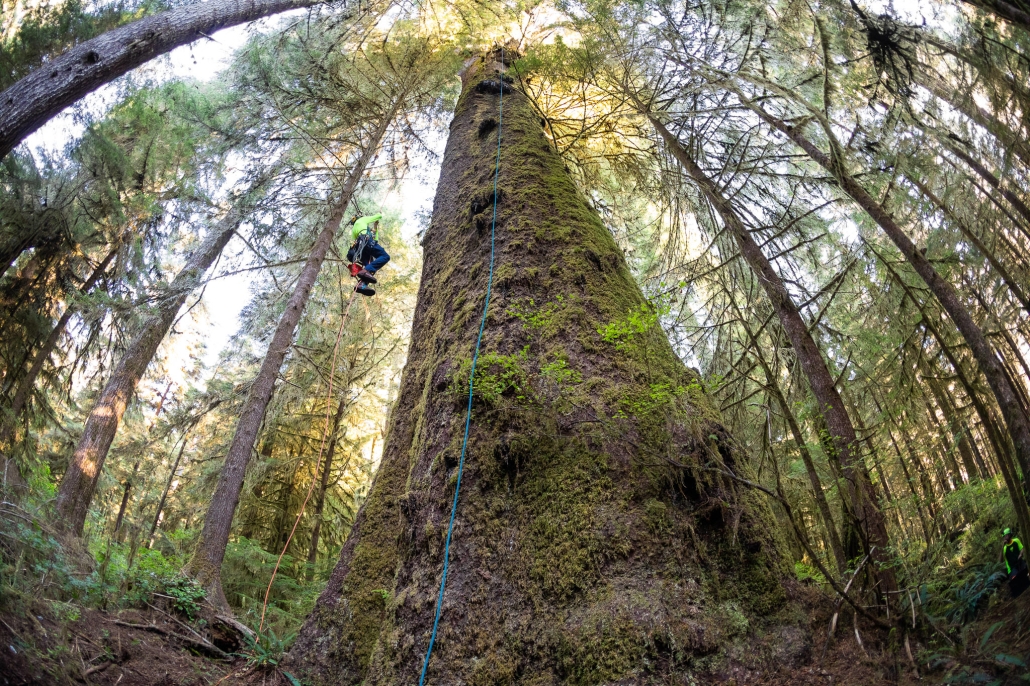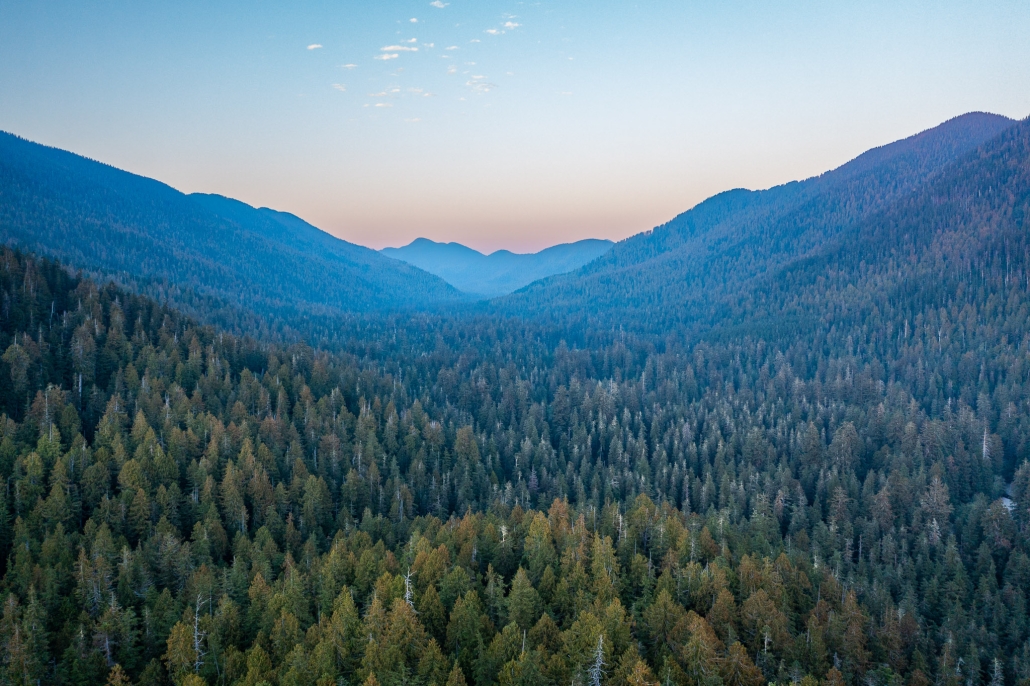 Apr 23 2024
Apr 23 2024Conservationists locate and climb the largest Sitka spruce tree in BC’s famed Carmanah Valley
Spectacular drone footage and photos reveal climbers more than 20 stories in the air in the “hydra-like” canopy of an old-growth Sitka spruce, highlighting the incredible grandeur of old-growth forests in British Columbia during Earth Week.
Conservationists with the Ancient Forest Alliance (AFA) have located, climbed, and measured the largest spruce tree in the famed Carmanah Valley. The record-sized tree — whose mammoth trunk forks into multiple stems reminiscent of the multi-headed hydra of Greek mythology — grows protected within the Carmanah-Walbran Provincial Park in Ditidaht territory on Vancouver Island. The tree was identified by AFA’s TJ Watt and Ian Thomas while exploring the valley in the spring of 2022 and climbed later in the fall with the help of professional arborists. The images and videos are being released for the first time today to celebrate Earth Week.
See an incredible video of the climb and the full photo gallery.
The towering tree measures 12.9 ft (3.89 m) wide near its base, 233 ft (71 m) tall, and has an average crown spread of 72 ft (22 m). According to the BC Big Tree Registry, this makes it the largest tree in the Carmanah Valley (despite the famed “Carmanah Giant” being taller), and the fourth-largest Sitka spruce on record in BC. Two blue whales laid end-to-end would still not equal the height of this immense tree, which is one of the largest living organisms on Earth. Its immense, multi-stemmed crown has garnered it the nickname the “Hydra Spruce.”

Climber Will Clayton of Bartlett Tree Experts begins his ascent up the towering trunk of the largest spruce tree in the Carmanah Valley in Ditidaht territory on Vancouver Island, BC.
“This giant is by far the most spectacular Sitka spruce tree that we’ve come across during our decades-long search for big trees in BC,” noted AFA campaigner and photographer TJ Watt. “We had been big tree hunting in the valley for two days as part of my work as a National Geographic Explorer, when, just before dark, a massive crown caught our eye in the distance. Right away, we knew we had found something special. Most Sitkas are tall and straight like a Roman pillar, but this one had an enormous trunk that forked into five major stems, creating a sprawling canopy like the head of a hydra. Near the base, it would have taken seven or eight of us to wrap our arms around the trunk. Seeing it from the ground was one thing, but we knew that to truly highlight the tree’s grandeur, we would need to climb to the top.”
AFA later teamed up with professional arborists from Bartlett Tree Experts to ascend, document, and measure the ancient tree. Using a 12-foot “Big Shot” slingshot, the team fired a line over a large branch high up into the canopy. Then, using low-impact techniques where climbers ascend the ropes themselves rather than the tree’s trunk, they could reach within a few meters of the top of the tree. Lowering down a giant tape measure, they calculated a height measurement of 233 feet or 71 meters tall — as tall as a 21-story building.
“I’ve climbed thousands of trees in my life, but this one was like none other,” said arborist and climber Matthew Beatty with Bartlett Tree Experts. “Even within the Carmanah Valley, where we have climbed numerous trees for scientific research projects, this is a giant among giants. The feeling of being within an ancient canopy is an immersive, humbling, and awe-inspiring experience. I hope that by highlighting the magnificence of these rainforest ecosystems, we inspire people about the need to protect those forests still at risk outside the park boundaries.”

Climber Finn Rowlands dangles among the massive canopy of the Hydra Spruce during golden hour. All five trunks visible in this image are part of the same tree.
The Carmanah Valley has long been famous as one of the most superlative old-growth Sitka spruce forests left in Canada. Beyond the Hydra Spruce, it is home to Canada’s tallest known tree, the Carmanah Giant, which towers 315 feet (96 metres) in the sky. The Carmanah Valley was the focus of intense conservation efforts in the early 1990s when it was imminently threatened by logging. Big-tree hunter and conservationist, the late Randy Stoltmann, was a particular champion of protecting this exceptional valley. After intense public pressure, the entire watershed was eventually protected as a provincial park alongside sections of the nearby Walbran Valley. The Carmanah is now celebrated as one of the most magnificent old-growth forests on Earth, with visitors coming from across the world to walk through its vast pillars of enormous trees.
Pioneering research in the canopies of tall trees in the Carmanah Valley in the early 1990s also revealed thousands of invertebrates living in the lush jungle of epiphytic ferns, mosses, and lichens. Many of these species were entirely new to science and are believed to only live in the crowns of old-growth trees and nowhere else on Earth. Other inhabitants of these unique “sky gardens” include wandering salamanders, which recent research suggests may “glide” from branch to branch like flying squirrels, and the endangered marbled murrelet. This tiny seabird nests on the mossy cushions found on the immense branches of old-growth trees.
“When we walk among trees at ground level, huge as they seem, we are often only seeing one third of the tree, which can extend hundreds of more feet into the air,” said Watt. “Climbing into the canopy of a giant old-growth tree is like entering a lost world seen by very few people. Their branches can be as big as regular-sized trees and are often adorned with suspended gardens, overflowing with mosses, ferns, lichens, and shrubs. In those moments, you realize the vast ecological value of even a single old-growth giant. They are worlds unto themselves, with creatures that might live their entire lives in the canopy without ever touching solid ground. These ancient giants are like huge, living apartment buildings that have grown over centuries, housing uncountable numbers of individual creatures and species. These trees are irreplaceable in our lifetimes. I hope the images and videos we’ve captured here inspire reverence and awe in those who see them and inspire people to engage and speak up for protecting old-growth forests across BC.”
Research has shown that in addition to their immense ecological value in providing habitat for wildlife, supporting biodiversity, maintaining clean water, sequestering carbon, and buffering against climate change, standing old-growth forests and protected areas provide greater economic benefits to communities in the longer term when compared to logging them. Factoring in ecotourism, recreation, non-timber forest products, carbon credits, and enhanced real estate values, among other industries, standing old-growth forests have been shown to provide greater economic benefits over time than the one-time economic benefits gained from cutting them down.
“Carmanah is a perfect example of what society gains when we set aside large areas for nature. Thirty years after it was saved from logging, Carmanah still has vast stands of the giant trees that have been decimated elsewhere in BC. It still harbours threatened species such as marbled murrelets and western screech owls, and, it’s still a place of hidden natural wonders, where we can seek out and document some of the largest and oldest living beings on Earth,” stated Watt. “Conservationists 30 years ago gave us this gift; without them, the valley and its skyscraper trees would be another stump field transitioning to an industrial tree farm. We must give that same gift — healthy ecosystems and protected old-growth forests — to future generations.”

Climber Matthew Beatty near the top of the tree, which measures 233 feet (71 m) tall – as tall as a 21-story building.
As the BC government develops its new Old-Growth Strategy as part of a larger mandate to expand protection to 30% of BC by 2030, it must commit to legally binding ecosystem-based protection targets. These must factor in “forest productivity distinctions” (differentiating between sites that grow large trees vs. sites that typically grow small trees in cold, rocky, or boggy sites) set by science and Traditional Ecological Knowledge committees. These critical distinctions are vital to ensure the most at-risk and least-protected ecosystems are prioritized — otherwise, protection will still be largely focused on alpine and subalpine areas with low to no timber values.
Old-growth forests have unique characteristics not found in the ensuing second-growth tree plantations that they are being replaced with. These forests are typically re-logged every 50 to 60 years on BC’s coast, never to become old-growth again. Old-growth forests support endangered species, the multi-billion dollar tourism industry, carbon storage, clean water, wild salmon, and First Nations cultures. Well over 90% of the high-productivity old-growth forests with the biggest trees and over 80% of the medium-productivity old-growth forests have been logged in BC.
This climbing project was part of AFA campaigner and photographer TJ Watt’s work as a National Geographic and Royal Canadian Geographical Society Explorer, supported by the Trebek Initiative. This grant supports emerging Canadian explorers, scientists, photographers, geographers, and educators with the goal of using storytelling to ignite “a passion to preserve” in all Canadians. Watt was among the first round of recipients in 2021.
All tree climbing and drone filming was done with permission from local governments.

The Carmanah Valley





